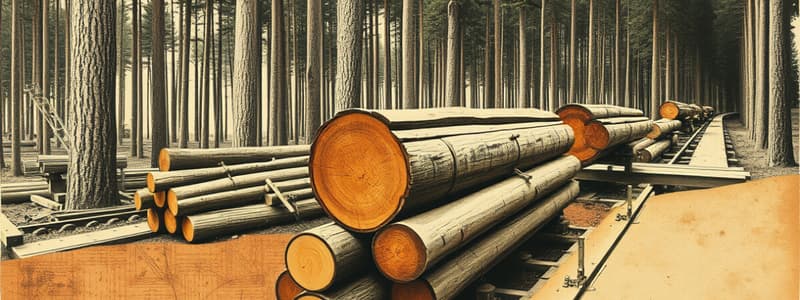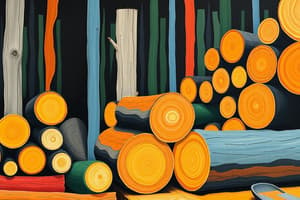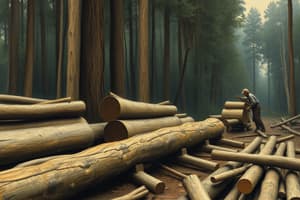Podcast
Questions and Answers
What role do primary trees play in the growth of new trees?
What role do primary trees play in the growth of new trees?
Primary trees provide seeds essential for the growth of new trees.
How do trees prevent erosion in rainforests?
How do trees prevent erosion in rainforests?
Trees prevent erosion by holding the soil firmly with their roots, which helps to retain nutrients in the topsoil.
What are the potential consequences of deforestation on flooding?
What are the potential consequences of deforestation on flooding?
Deforestation can lead to soil instability, resulting in increased flooding and mudslides.
Explain how sedimentation from erosion affects aquatic life.
Explain how sedimentation from erosion affects aquatic life.
What impact does cutting down trees have on climate change?
What impact does cutting down trees have on climate change?
What are the four phases of lumbering?
What are the four phases of lumbering?
Why is logging primarily conducted in winter months in certain countries?
Why is logging primarily conducted in winter months in certain countries?
What role do railroads play in lumbering operations?
What role do railroads play in lumbering operations?
How does the geography of Canada influence its lumbering industry?
How does the geography of Canada influence its lumbering industry?
What types of trees are most significant to Canada's lumbering industry and why?
What types of trees are most significant to Canada's lumbering industry and why?
What is the primary use of the soft wood harvested in Canada?
What is the primary use of the soft wood harvested in Canada?
How do seasonal farmers participate in the lumbering industry?
How do seasonal farmers participate in the lumbering industry?
What happens to the logs piled above frozen rivers in Canada during spring?
What happens to the logs piled above frozen rivers in Canada during spring?
What historical factors contributed to the emergence of the wood industry in Canada?
What historical factors contributed to the emergence of the wood industry in Canada?
What are the main differences between hardwood and softwood trees?
What are the main differences between hardwood and softwood trees?
Which province in Canada produces roughly two-thirds of the softwood lumber supply?
Which province in Canada produces roughly two-thirds of the softwood lumber supply?
Describe the process of debarking in lumber manufacturing.
Describe the process of debarking in lumber manufacturing.
What role do optical sensors play in the production of lumber?
What role do optical sensors play in the production of lumber?
What is the purpose of seasoning in the lumber manufacturing process?
What is the purpose of seasoning in the lumber manufacturing process?
Why is winter considered the preferred season for lumbering activities?
Why is winter considered the preferred season for lumbering activities?
What challenges do lumberjacks face in their work environment?
What challenges do lumberjacks face in their work environment?
What environmental impact does lumbering have on biodiversity?
What environmental impact does lumbering have on biodiversity?
In what ways has modern machinery affected the lumberjacking profession?
In what ways has modern machinery affected the lumberjacking profession?
What types of products are created by the lumber and wood industries?
What types of products are created by the lumber and wood industries?
What is the significance of sawmills in the lumbering industry?
What is the significance of sawmills in the lumbering industry?
How has the historical timber trade shaped Canada's economy?
How has the historical timber trade shaped Canada's economy?
What are some processes involved in turning logs into usable lumber?
What are some processes involved in turning logs into usable lumber?
Flashcards
What is Lumbering?
What is Lumbering?
The process of cutting down trees for the production and use of wood.
What is Logging?
What is Logging?
The first phase of lumbering, involving the felling and extraction of trees.
What is Driving in Lumbering?
What is Driving in Lumbering?
The movement of logs from collection points to sawmills.
What is Manufacturing in Lumbering?
What is Manufacturing in Lumbering?
Signup and view all the flashcards
What is Transport in Lumbering?
What is Transport in Lumbering?
Signup and view all the flashcards
When is Logging Typically Done?
When is Logging Typically Done?
Signup and view all the flashcards
How are Logs Transported in Logging?
How are Logs Transported in Logging?
Signup and view all the flashcards
How is Driving Facilitated?
How is Driving Facilitated?
Signup and view all the flashcards
What are the Main Tree Types for Lumber?
What are the Main Tree Types for Lumber?
Signup and view all the flashcards
What are Hardwoods?
What are Hardwoods?
Signup and view all the flashcards
What are Softwoods?
What are Softwoods?
Signup and view all the flashcards
Which Tree Species Dominate Canadian Lumbering?
Which Tree Species Dominate Canadian Lumbering?
Signup and view all the flashcards
Where is Softwood Lumber Production Concentrated in Canada?
Where is Softwood Lumber Production Concentrated in Canada?
Signup and view all the flashcards
Where is Hardwood Lumber production Concentrated in Canada?
Where is Hardwood Lumber production Concentrated in Canada?
Signup and view all the flashcards
What is Canada's Role in Lumber Production?
What is Canada's Role in Lumber Production?
Signup and view all the flashcards
What Happens to Logs During Winter?
What Happens to Logs During Winter?
Signup and view all the flashcards
Where are Canada's Major Forests Located?
Where are Canada's Major Forests Located?
Signup and view all the flashcards
What are Some Key Lumbering Products?
What are Some Key Lumbering Products?
Signup and view all the flashcards
How are Lumber Products Manufactured?
How are Lumber Products Manufactured?
Signup and view all the flashcards
What is the First Step in Lumber Manufacturing?
What is the First Step in Lumber Manufacturing?
Signup and view all the flashcards
What is Debarking in Lumber Manufacturing?
What is Debarking in Lumber Manufacturing?
Signup and view all the flashcards
What is Bucking in Lumber Manufacturing?
What is Bucking in Lumber Manufacturing?
Signup and view all the flashcards
How are Logs Cut and Edged?
How are Logs Cut and Edged?
Signup and view all the flashcards
What are the Final Steps in Lumber Manufacturing?
What are the Final Steps in Lumber Manufacturing?
Signup and view all the flashcards
How does Frozen Ground Help Lumbering?
How does Frozen Ground Help Lumbering?
Signup and view all the flashcards
Who are Lumberjacks?
Who are Lumberjacks?
Signup and view all the flashcards
How has Lumbering Changed?
How has Lumbering Changed?
Signup and view all the flashcards
What is a Major Environmental Impact of Lumbering?
What is a Major Environmental Impact of Lumbering?
Signup and view all the flashcards
How does Lumbering Affect the Environment?
How does Lumbering Affect the Environment?
Signup and view all the flashcards
What is the Impact on Flooding?
What is the Impact on Flooding?
Signup and view all the flashcards
What is the Impact on Rivers?
What is the Impact on Rivers?
Signup and view all the flashcards
What is the Impact on Climate Change?
What is the Impact on Climate Change?
Signup and view all the flashcards
Study Notes
Lumbering Overview
- Lumbering refers to tree cutting for wood production in domestic, industrial, or commercial sectors.
- The four phases of lumbering are logging, driving, manufacturing, and transport.
- Logging is typically limited to winter months when snow and ice facilitate transportation.
Logging Process
- Logs are dragged by horses or oxen over snow-covered terrains to collection points.
- Driving is the movement of logs from collection points to sawmills, utilizing railroads when necessary.
- Manufacturing cuts logs into lumber products such as planks and boards, primarily for construction and paper.
- Transport includes finding buyers and delivery to markets, with local mills selling to nearby residents.
Lumbering in Canada
- Canada, rich in coniferous forests, covers about 40% of its land area with these resources.
- Major forests extend from Newfoundland to British Columbia, facilitating extensive lumber production.
- Canada is the world's leading wood products exporter, contributing to one-third of global lumber and timber markets.
- Lumbering is a significant winter activity; logs are temporarily stored on frozen rivers for spring transport.
Tree Species
- Lumber is produced from hardwood (e.g., oak, maple, birch) and softwood (e.g., pine, fir, spruce) trees.
- Canadian forestry is dominated by softwood species, specifically spruce, pine, and hemlock, primarily harvested in British Columbia.
- Hardwood lumber production is concentrated in Ontario and Quebec.
Lumbering Products
- Key products include lumber, veneer, plywood, particle board, wood pellets, and engineered wood.
- Manufacturing processes involve mechanical methods such as sawing and peeling.
Manufacturing Process
- Inspection involves cleaning logs and checking for defects before processing.
- Debarking uses high-powered jets or cutting blades to remove bark, often repurposed for decoration.
- Logs are cut into sizes (bucking logs) for various uses, with water sprayed to avoid drying.
- Cutting and edging involve optical sensors and computer mapping for optimal cuts, with manual oversight.
- Planing and grading prepare the wood, ensuring quality before packaging and shipment.
Factors Favoring Lumbering
- Limited species of coniferous trees are well-suited for winter logging.
- Frozen ground facilitates easier transport of logs to rivers for floating to sawmills.
- Access to hydroelectricity enhances sawmill operation in mountainous regions, supporting efficient lumbering.
Life of a Lumberjack
- Lumberjacks epitomize strength and masculinity in Canada, crucial to the timber industry since its rise.
- In the 19th century, half of Canadian males were lumberjacks; modern machinery now allows female participation.
Environmental Effects of Lumbering
- Biodiversity Loss: Habitat destruction threatens species survival and ecosystems reliant on primary trees.
- Erosion: The loss of trees leads to soil degradation and nutrient loss, making environments barren.
- Flooding: Deforestation compromises soil stability, increasing risks of floods and mudslides, endangering lives and properties.
- River Obstruction: Soil erosion leads to sedimentation in rivers, disrupting aquatic habitats critical for species like salmon.
- Climate Change: Deforestation releases stored carbon, increasing greenhouse gas concentrations and contributing to global warming's adverse effects, including extreme weather events.
Studying That Suits You
Use AI to generate personalized quizzes and flashcards to suit your learning preferences.




